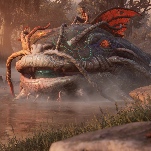Oxenfree II: Lost Signals Is A Leaner Sequel That Hums At A Great Frequency

Oxenfree is an exceptionally hard act to follow. When I played the original, I was like its characters: a wayward teenager stuck in a malaise of relationships I was too closed off from who needed something to shake me out of it. Oxenfree’s horror imagery—rooted in otherworldly geometric shapes and faint afterimages— as well as its patched-together radio soundscape burrowed into my brain and never really left. The delivery of “Is. Leave. Possible.” is simply some of the best VO work I’ve heard in games, and that was damn near seven years ago. Its ending(s) and the ambiguity around them, even the looseness of the threads on which the game pulled, felt ripped out of real life and its lack of absolute conclusions and closure. Was it perfect? No, but it was to me at the time that I played it, producing a tall order for Oxenfree II: Lost Signals to live up to. It doesn’t entirely get there, but Oxenfree II is still great in its own right.
Riley and Jacob, Oxenfree II’s new protagonists, breathe some fresh air into what could have been a stale return to the world of Edwards Island. They’re both kind of screwed up adults who, for better or worse, need a night of chasing a teenage cult around Camena to shake off and fight their own demons. Riley, our player character, is coming back to Camena after a long time away, and evidently a lot of that has to do with her own upbringing, parents, and her concerns for her life moving forward. Jacob, on the other hand, never left Camena and struggles to feel like he’s leading a life worth living, let alone talking about. It’s a perfect cocktail for the Oxenfree “machine” as Night School founder Sean Krankel put it in an earlier conversation, whereby the developers subject their perfectly imperfect cast to the supernatural hauntings to shake something loose for them.
Though they don’t quite rise to the heights of Alex and her friends from the original game—perhaps because the sequel’s plot is really dominated by thwarting other characters who are moving on their own interesting trajectories rather than necessarily plumbing Riley and Jacob’s respective histories—the new heroes are still engaging to watch. The story, which is as rooted in the past as it is invested in the future these characters want to carve out, has a lot to do with letting go of that baggage that tends to weigh someone down—-the kind of stuff that freezes you in place or makes you slide backwards. It’s a universal bit of angst that neatly envelops the older protagonists and their teenage opponents. While Riley and Jacob strive for better futures (and a return to normalcy on that cursed night) the younger cast of pseudo-antagonists are trying to channel the ghosts of Oxenfree in order to cling onto something from the past. Everyone’s fighting some war behind their eyes on the night that these groups clash.
-

-

-

-

-

-

-

-

-

-

-

-

-

-

-

-

-

-

-

-

-

-

-

-

-

-

-

-

-

-

-

-

-

-

-

-

-

-

-

-








































